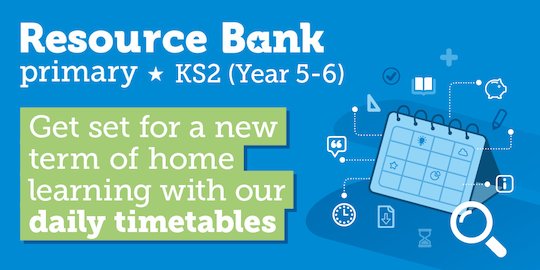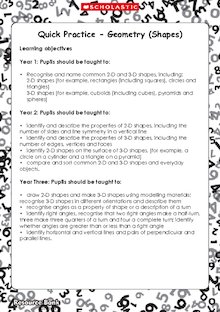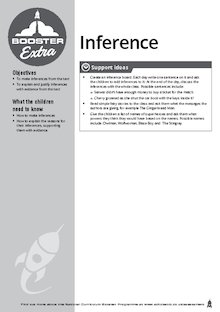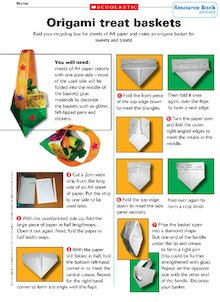Upper Key Stage 2 daily timetables – Week 2
- 5 Stars
- Supports home learning
Add to My Folder
We have created these Upper KS2 daily home-learning timetables to help your children aged 9-11 (Years 5-6) stay engaged and entertained from 9am–3.15pm!

Each timetable includes an hour’s learning on the core subjects of English and Maths, with sessions for other curriculum coverage and time for reading, breaks, snacks and daily exercise.
*Remember not all days will go to plan and your child might not always be able to sit and work quietly for the allocated time. If needed, allow your child/children to pick and choose which activities they would like to do, or encourage them to focus on just one piece of learning per day.
Timetables:
1. Monday
2. Tuesday
3. Wednesday
4. Thursday
5. Friday
Monday
| Time: | Subject: | Notes: |
|---|---|---|
| 9.00-9.30 | PE |
Outcome/purpose: Practise throwing and catching with a soft ball, small cushion or soft toy. Set yourself challenges such as: Clap your hands a number of times before you catch Use one hand to catch – place the other hand behind your back Spin around whilst the ball/cushion or soft toy is in the air and then catch it Juggle more than one ball/cushion/soft toy Optional parent support: Play catch with your child and try the challenges when throwing to each other. |
| 9.30-10.30 | Maths |
Outcome/purpose: To find the angles in a triangle. To know the properties of different shapes. Instructions: Download the ‘Quick Practice – Geometry pack’ here. Go to page 12 (for Year 5 pupils) or page 14 (for Year 6 pupils). Complete the activities on the pages. If you have time, see if you can complete this maths problem: Write down all the letters of the alphabet with parallel lines. Which ones have perpendicular lines? Which have both? Optional parent support: Check your child’s answers for errors and help them with any corrections. Play the games on page 13 (Year 5) or page 15 (Year 6) with your child. |
| 10.30-11.00 | Break |
Pop out for your daily walk or exercise!
Remember to have a healthy snack such as a piece of fruit and don’t forget to wash your hands before you eat. |
| 11.00-11.30 | Reading |
Outcome/purpose: To read for 30 minutes. Instructions: Snuggle up with a book! Choose one of your favourite books and read for half an hour. Optional parent support: Ask your child to read aloud to you and ask them questions about the story. Such as: Can you summarise what has happened so far? Which words/phrases tell you he is angry? Can you point to a noun (collective, proper, common, abstract), adjective and verb? |
| 11.30-12.30 | Geography and Science |
Outcome/purpose: To learn about endangered animals. Instructions: Download the PowerPoint ‘Home Learning: Protecting Our Planet – Endangered species’ and the related activity notes ‘Home Learning: Protecting Our Planet – Endangered species notes’. Open the PowerPoint in ‘slideshow view’. Read the notes as you go through the slides and complete the activities. Optional parent support: Read through the PowerPoint and notes with your child and check that they understand the reasons why animals become endangered and any tricky vocabulary. |
| 12.30-1.30 | Lunch | If you have a garden or balcony, try to get some fresh air after lunch. Remember to wash your hands before eating! |
| 1.30-2.30 | English – Reading |
Outcome/purpose: To make inferences from the text. To explain and justify inferences with evidence from the text. Instructions: Year 5 activity: Download the PowerPoint ‘Inference and deduction – slideshow’. Read the text in the blue box on each slide and then answer the questions below. Write down your answers on a separate piece of paper. Year 6 activity: Download ‘KS2 SATs Reading Booster Extra Pack: Inference’. Read the text from page 2 onward and answer the questions. Optional parent support: Year 5: Go through the slides with your child and check that their answers are correct. Ask them what clue lead to their answer. Year 6: Use the answer sheet to check your child’s answers (page 6). |
| 2.30-3.15 | Art |
Outcome/purpose: To create an origami treat basket. Instructions: You will need: A4 paper, glue, scissors, materials to decorate your basket such as glitter, felt tip pens and stickers. Follow the instructions on the worksheet to make your treat basket. Optional parent support: Work through the instructions with your child if they struggle to follow them independently. |
Scholastic Resource Bank: Primary - join today!
- Over 6,000 primary activities, lesson ideas and resources
- Perfect for anyone working with children from 5 to 11 years old
- Unlimited access from just £1.25 per month
Already a member? Sign in below.
Published 24 April 2020
Reviews
Rated 5/5 from 1 rating
You need to be signed in to place a review.



